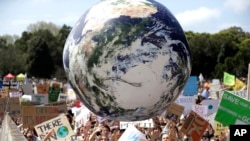Australia will launch a bid with Pacific nations to hold the United Nations climate summit in 2026.
For years Australia lagged behind other developed countries on its climate action. A conservative government — in power for almost a decade until it lost an election in May — was a staunch supporter of the fossil fuel industry.
Coal and gas continue to generate much of Australia's electricity.
But the recently-elected Labor government is seeking to present Australia as a renewable energy powerhouse on the global stage.
It wants to co-host COP31 — the United Nations climate summit in 2026 — with its Pacific Island neighbors.
Worried by rising sea levels and an increased frequency and severity of tropical storms, regional leaders have said that climate change is an existential threat.
Chris Bowen, Australia's minister for climate change and energy, told a media conference in Sydney Saturday that co-hosting the climate summit would "help elevate the case of the Pacific for more climate action."
Conservationists have welcomed Australia’s bid to co-host the COP31 climate talks, although they insist Canberra should do more now to stop new coal and gas developments.
Simon Bradshaw, a projects research director at the Climate Council, a non-profit campaign organization, told the Australian Broadcasting Corp. Monday that Labor's climate policies would be received more favorably at the U.N. meeting in Egypt.
This current COP27 — or Conference of the Parties — climate summit in Egypt is running from Nov. 6 to Nov. 18.
"This conference also follows what has been an extraordinary run of climate-fueled disasters right around the world," Bradshaw said. "Of course, many Australians have felt this very directly with our on-going flood situation and, of course, Australia has shown up, it is back in the game but will be under a lot of pressure like everyone else to really step up and do its best."
For the first time, Australia has a legislated target to cut greenhouse gas output.
In September, new laws were passed by the federal parliament in Canberra that will cut carbon emissions by 43% by 2030.
Parts of Australia have had serious flooding during the past two years. The New South Wales town of Forbes, 400 kilometers west of Sydney, endured near-record flooding on Saturday and Monday, and remains inundated.
Other communities along the Barwon-Darling River in north-western New South Wales are expected to remain isolated for weeks.
Two climatic phenomena — La Niña and the Indian Ocean Dipole — are fueling the flooding. They are influenced by warmer ocean temperatures and have dumped above-average rainfall across much of Australia. They both occur naturally but experts have said they are being super-charged by climate change.










